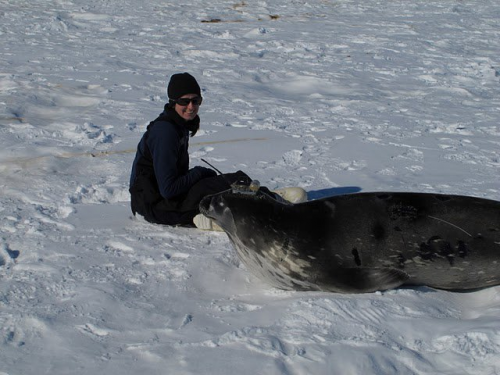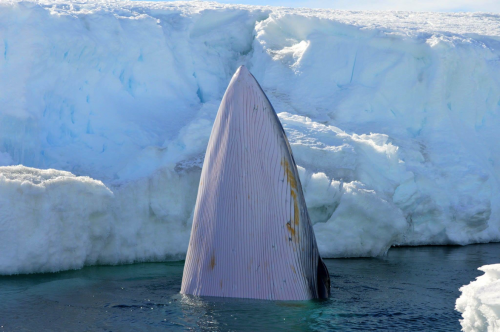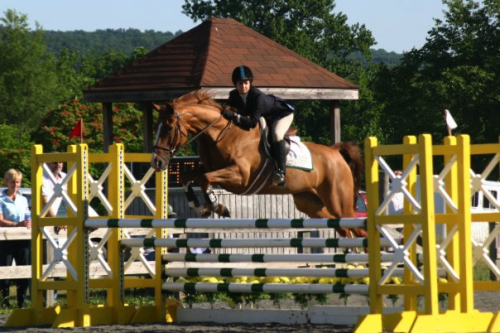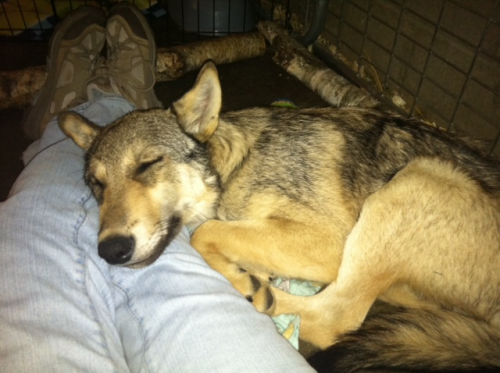 Meet the Team – Michelle Shero
Meet the Team – Michelle Shero
Meet Michelle Shero
I’m Michelle Shero, a Ph.D. student living in Anchorage, Alaska. I came here all the way from the east coast, where I grew up in Maryland. I went to school at St. Mary’s College of Maryland, a gorgeous waterfront liberal arts school, where almost all of my biology classes put us in the water!
 Just Another Day in Class, Michelle working in the St. Mary’s River, off the Chesapeake Bay, Photo credit: Michelle Shero.
Just Another Day in Class, Michelle working in the St. Mary’s River, off the Chesapeake Bay, Photo credit: Michelle Shero.
What’s after graduate school?
There’s so many options! After I finish school, I really just want to continue the work I’m doing now, with new questions, new species, new opportunities and new ways to work with other researchers and students to better understand how animals can live (and thrive!) at the extremes. It never gets old.
About the Weddell seal project
Main role on the team
Most of my graduate work actually deals with the Weddell seals we handled the last time Alex came to McMurdo with us. I am looking at how much Weddell seals have to ‘fatten-up’ over the Antarctic winter, when they are pregnant, in order to come back and successfully have a pup. These pregnant seals have to work harder over the winter to eat more prey and gain more energy to support a pup, so I’m also really interested in how they do this. Are pregnant seals diving longer, deeper and more often?
Hint: The answer is YES! Weddell seals can also hold their breaths for an amazingly long time. The record is 96 minutes!!! So another big question I’m trying to answer in my graduate work is whether there are certain times of the year that animals really start to ‘push their limit’ with regards to breath-holding.
Our last project was ALL over the winter. So, this new project brings about a whole new season — summer! And we all have tons of questions about what the seals are doing then. My main role in this project is working with our veterinarians to see when pregnancy really starts in Weddell seals. We are starting to see that timing and the likelihood of becoming pregnant really depend on whether seals were busy that year with nursing their pups, or not.
 Check this out... the development of a tiny embryo compared to a larger embryo. Photo credit: Michelle Shero.
Check this out... the development of a tiny embryo compared to a larger embryo. Photo credit: Michelle Shero.
What’s the highlight of this project?
In addition to being able to go back to the absolute COOLEST place in the world, I am also really looking forward to all the new techniques I’m going to learn. I get to ‘play’ with ultrasound equipment and learn from experts how to detect really early pregnancy in wild animals. There’s only a few of these experts in the world that can find these little embryos (they can be smaller than 3 mm!). With how much we know about Weddell seals, there are SO many questions we hope to answer with this project that wouldn’t be possible with any other species.
What ‘big question’ do you hope this project answers?
Some of the major life history events in seals are: pupping/nursing, breeding and the molt. These cost the seals a lot of energy, and so it would seem much better if the seals could keep each event separate from the others. The ‘big question’ I hope that this project answers is how the seals do this: what is important for the seals to do for themselves (get fat, use hormones), and what is important for the seals to get from the environment (we’ll see this by more diving). This would also be really meaningful for other species that people don’t know as much about and are much harder to study.
Please share your favorite picture of a Weddell seal… and one with you and a Weddell seal.
 Of course, the pups are the cutest. Photo credit: Michelle Shero.
Of course, the pups are the cutest. Photo credit: Michelle Shero.
 Michelle with a Weddell seal that has just gotten a tag to track what she does over the winter. Photo credit: Jenn Burns.
Michelle with a Weddell seal that has just gotten a tag to track what she does over the winter. Photo credit: Jenn Burns.
What’s the coolest part of your school work?
Hands down, the coolest part of my job is being able to ask questions and look for answers in Antarctica. When I first started school, I thought I would be SO happy just being able to go to McMurdo once. But after you see it, once is not enough! Every year I’ve gone to the Antarctic, the experience has been completely different. Some years, it’s been cold with windstorms all season. Other years, it’s been 35°F almost the whole time. Some years, there is tons of ice for us to snowmachine on, and we run into lots of penguins! Other years, all the ice melts and there are lots of whales instead.
 Penguin visitors in McMurdo. Photo credit: Michelle Shero.
Penguin visitors in McMurdo. Photo credit: Michelle Shero.
 Curious minke whale spy-hopping a few feet away from us! Photo credit: Michelle Shero.
Curious minke whale spy-hopping a few feet away from us! Photo credit: Michelle Shero.
What is the most exciting, most amazing, or scariest thing that has happened to you during your school work?
It’s hard to pick just one... Every day out on the ice is an adventure.
What are some of the perks of your school work?
The other fun part about graduate school is how many opportunities there are out there for travel. We go to New Zealand and Antarctica every year, but we get to go to amazing places for many other reasons, too. I’ve gotten to present my work to other researchers and just have fun talking about science in Spain and France. I’ve taken a marine biology courses in Belize. And I took a class in Svalbard, Norway for 6 weeks about how researchers use tags to collect data for animal physiology, dive behavior, communication and where animals go. I’ve also gotten to do some work on the Pribilof Islands off the coast of Alaska looking at the northern fur seal population, and done a ship cruise in Prince William Sound, Alaska to capture and tag Steller sea lions. You have to be pro-active about it, but there are tons of opportunities for travel and meet new people that have done the most amazing things.
 Polar bear with two cubs in Svalbard, Norway. Photo by: Michelle Shero.
Polar bear with two cubs in Svalbard, Norway. Photo by: Michelle Shero.
If asked to ‘sell’ this career to someone, what would you say to convince them to pursue it?
There is never a dull moment in graduate school and doing scientific research. There is always excitement, and you are constantly trying to fit missing puzzle pieces together to answer your research questions. It is hard work (although, it doesn’t really feel like work!) and takes a lot of devotion to your project, but it is incredibly worthwhile when all the pieces fall into place and you realize you’ve found something really cool and totally new, that no one else knows about.
What advice would you give a student interested in pursuing your career?
In this field, I think the most important thing is just being excited and loving what you do. Ask questions, seek out opportunities and just do what you like doing.
Fun Questions
Who inspired you on this path?
There are so many people who inspired me on this path: parents, friends, teachers. All of them have been incredibly supportive.
What did you want to be when you were a 10 year old?
When I was 10 years old, I wanted to be a veterinarian. I started watching our small animal veterinarian’s surgeries when I was in third grade. I also grew up with horses and competed in the A-rated show-jumping circuit, while shadowing an equine veterinarian for years. Actually, I wanted to be a veterinarian until I was 20 years old! During college, I wound up having numerous opportunities to do scientific research. One of them was a summer internship in Anchorage, Alaska…. My original plan was that I would only spend one summer in Alaska. And I guess Jenn Burns made the science and seal work look like SO much fun that I signed up as a PhD student after that. I’m currently in my 4th year and loving it!
 Show-jumping with my horse, Annie. Photo credit: Michelle Shero.
Show-jumping with my horse, Annie. Photo credit: Michelle Shero.
What were your favorite books, shows and/or movies when you were a kid?
When I was a kid, my favorite books were:
- The Harry Potter books
- All of Judy Blume’s books
- The Phantom Tollbooth
- Where the Red Fern Grows
I always watched ‘Boy Meets World’ and ‘Sabrina the Teenage Witch’.
My favorite movies when I was little were Beauty & the Beast, Homeward Bound, Home Alone and Fly Away Home.
Which super power would you like to have and why?
Flight! The view would be amazing, and it would mean a lot less airplanes to get to Antarctica!
If you could be any animal, what would it be and why?
I would be a wolf. They’re intelligent, elegant and fierce at the same time, and the pack structures they have are amazing.
 Michelle could be any animal, she'd be a wolf. Photo Credit: Unknown.
Michelle could be any animal, she'd be a wolf. Photo Credit: Unknown.
 4-month-old Boltz at the International Wolf Center in Minnesota. Photo credit: Michelle Shero
4-month-old Boltz at the International Wolf Center in Minnesota. Photo credit: Michelle Shero
Besides Antarctica, where in the world would you like to visit?
I would still really like to go to Africa for a real safari.

